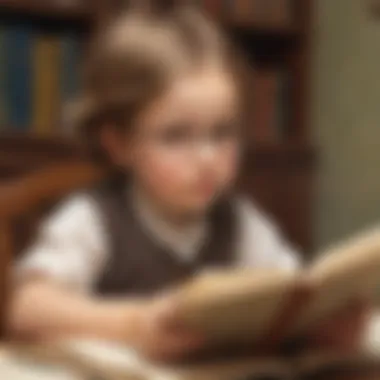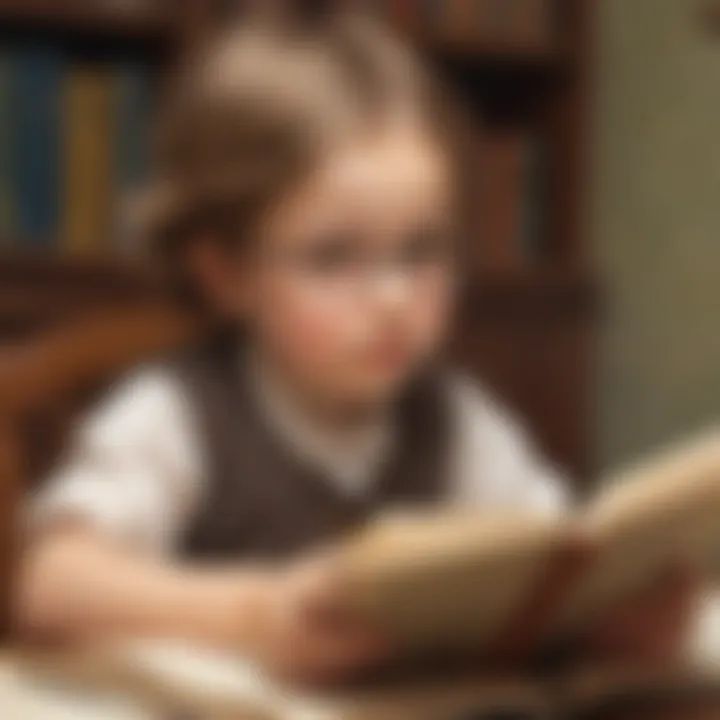Essential Biographies for Third Graders: A Guide


Intro
Biographies serve as windows into the lives of extraordinary individuals. For third graders, these stories can spark curiosity and foster a deeper understanding of diverse backgrounds. This guide aims to showcase essential biographies that resonate with young readers while encouraging literacy and personal growth. Each book selected highlights significant figures across various fields, offering insight into their contributions and challenges.
The importance of biographies in a child’s educational journey cannot be overstated. They introduce children to real-life role models, giving them the opportunity to learn about resilience, creativity, and passion. In this guide, we will delve into selected biographies, examining their themes, writing styles, and relevance. We will also discuss how these books can be effective tools for educators and parents.
Creative Activities
Engaging with biographies does not have to end with reading. There are numerous creative activities that children can participate in to further explore the themes and individuals they learn about.
Craft Ideas
Here are some craft ideas that children may enjoy as they learn about specific figures in biography:
- Character Puppets: Use paper bags or sock puppets to create representations of important figures.
- Time Capsules: Have children fill a box with items that symbolize the person's achievements or time period.
- Posters: Encourage kids to create posters showcasing key facts and illustrations related to their chosen biography.
Step-by-Step Guides
Each craft can be made with simple materials. For example, for the character puppets:
- Gather materials such as paper bags, markers, and fabric scraps.
- Discuss the figure and brainstorm features that should be included in the puppet design.
- Create the puppet, focusing on key elements of the biography.
- Present the puppet and share fun facts about the character’s life.
Educational Value
These activities boost creativity and help reinforce what children have read. Crafting allows children to express their understanding of the biography and encourages discussions with peers and family.
Fun Quizzes
To further enhance comprehension, quizzes can be an enjoyable tool for learning.
Quiz Topics
On platforms like ElemFun, quizzes can cover various topics, such as:
- Major life events of the featured figures.
- Contributions to society.
- Key challenges they overcame.
Question Types
Quizzes can include multiple-choice questions, true/false statements, and short answer questions, ensuring engagement through diverse formats.
Knowledge Reinforcement
Quizzes help solidify knowledge by prompting children to remember and reflect on the information they have studied. This knowledge retention is essential for both academic growth and personal understanding of historical figures.
Fact-Based Articles
Fact-based articles are another resource that pairs well with biographies. These can help in understanding broader topics.
Topics
Topics can range widely, from significant periods in history to contributions made by various individuals in multiple fields.
Engaging Content
The articles should present facts in an engaging way. Using simple language helps facilitate understanding, making complex information accessible to third graders.
The Role of Biographies in Education
Biographies play a crucial role in education, especially for young learners. These narratives introduce students to the lives of notable figures, making history and achievements come alive. Through biographies, children learn not just about facts, but about the journeys and challenges faced by individuals. This form of storytelling captivates their imaginations and encourages a deeper understanding of diverse paths.


Reading biographies nurtures critical thinking skills. As students analyze the motives behind actions and the context of various eras, they begin to form opinions and make connections. This process supports the development of analytical abilities that they will use throughout their education.
Moreover, biographies foster curiosity. When children read about different people, they often feel inspired to learn more about the world. Whether it is a scientist, a leader, or an artist, each story has the potential to ignite a passion in young readers. They start to ask questions, seek answers, and explore new viewpoints. This curiosity is an essential part of becoming an informed citizen.
"Biographies provide windows into lives that can inspire action and the pursuit of knowledge."
In an era of globalization, understanding diverse perspectives is vital. Biographies showcase the rich tapestry of human experience across cultures and history. Children can see how people from different backgrounds have contributed to society, enriching their awareness and empathy.
Additionally, introducing biographies early in education establishes a foundation for lifelong reading habits. Students who engage with compelling life stories are more likely to develop a love for reading. This habit can lead to improved literacy skills and a greater willingness to tackle complex subjects in the future.
In all, the role of biographies in education is multifaceted. They not only educate but also inspire and empower young minds to explore their own potential.
Criteria for Selecting Biographies
Selecting the right biographies for third graders is crucial. The chosen works can shape their understanding of the world. They introduce young readers to historical figures, scientists, and innovators. However, not all biographies are suitable for this age group. Important criteria must guide the selection process, ensuring that the biographies are engaging and educational.
Age Appropriateness and Reading Level
When choosing biographies for children, age appropriateness is a primary concern. Third graders typically read at a specific level, which should be matched by the complexity of the text.
Biographies need to be accessible. They should avoid overly complex language that might frustrate young readers. This age group is ready for stories that range from 600 to 1,000 words. The sentences should be clear and structured, allowing for comprehension without excessive effort. Additionally, illustrations can aid in understanding. Here are key points to consider:
- Vocabulary Consideration: Ensure the vocabulary aligns with third-grade standards.
- Theme Relevance: Themes should be relatable to children, such as friendship, courage, and exploration.
“The right biography can inspire and empower a young mind.”
Relevance to Modern Themes
In today's ever-changing world, biographies that resonate with modern themes are significant. Young readers benefit from understanding current societal challenges and advancements. Selecting biographies that incorporate contemporary issues can foster a sense of belonging and awareness.
Look for biographies that discuss diversity, inclusion, and environmental responsibility. This relevance can spark discussions between children and their adults. Relevant themes can include:
- Social Justice: Figures who have worked towards fairness and equality.
- Science & Technology: Innovators in technology and environmental conservation.
This focus connects children with the world around them, making the reading experience more meaningful.
Authors and Writing Style
An engaging writing style is integral when it comes to biographies for third graders. The author’s ability to tell a story can make a significant difference. Biographies should present facts in an engaging manner.
Find authors who write in a narrative format, creating relatable characters. The writing should invoke empathy and understanding. Here are essential aspects:
- Narrative Approach: Biographies that humanize figures help children connect.
- Descriptive Language: Authors should use language that is vivid yet simple to hold attention.
By focusing on the authors and their writing style, caregivers and educators can select biographies that will not only inform but also engage young readers.
Recommended Biographies for Third Graders
Selecting appropriate biographies for third graders is a crucial aspect of education. At this age, children are developing their reading skills and curiosity about the world. Biographies serve not only to entertain but also to inform young readers about the lives of significant personalities. This fosters a sense of wonder while allowing them to learn valuable lessons from these figures.
When it comes to biographies, content matters. It should be age-appropriate and relatable. The right choices can inspire children, offering them models of achievement and resilience. By presenting authentic stories, we empower kids to dream larger and understand different cultures, values, and challenges.
Biographies of Historical Figures
Abraham Lincoln: A Life in Brief
Abraham Lincoln: A Life in Brief provides young readers insight into a key period in American history. The book highlights Lincoln's humble beginnings and his journey to becoming president. One major characteristic of this biography is its emphasis on perseverance. Lincoln faced numerous obstacles but remained dedicated to his beliefs. This makes it an excellent choice for inspiring courage in readers.
What stands out in this biography is its clear language. It effectively communicates Lincoln's values while being simple enough for third graders to grasp. A disadvantage might be that it does not delve deeply into some complex issues. However, this overview serves as a helpful introduction to Lincoln's life.


Marie Curie: A Pioneer in Science
Marie Curie: A Pioneer in Science showcases not only Curie's groundbreaking contributions to science but also her role as a trailblazer for women in STEM fields. A key aspect is her unyielding quest for knowledge, which inspires children to pursue their dreams. This biography illustrates Curie's tireless efforts and sacrifices, making it appealing for young minds yearning for role models.
Its unique feature lies in the clear explanation of scientific concepts in an accessible way. However, some aspects of her life could be challenging for young readers to understand fully. Despite this, it successfully highlights resilience and determination.
Nelson Mandela: The Road to Freedom
Nelson Mandela: The Road to Freedom focuses on Mandela's journey from prisoner to president. This biography demonstrates commitment to justice, which resonates with young readers. The book's narrative highlights resistance against oppression, making it a strong choice for discussing social issues.
One of its unique features is how it explains the struggle for freedom in an engaging narrative. However, the heavy themes of injustice and suffering might require guidance from parents or educators. This support can help children navigate the content thoughtfully.
Biographies of Inspirational Women
Rosa Parks: A Quiet Strength
Rosa Parks: A Quiet Strength illustrates the impact of one woman's act of courage on civil rights. The book emphasizes how simple actions can ignite change. Parks' story is compelling for children, reinforcing the idea of standing up for what is right.
The language is straightforward, making it easy to understand. Its challenge, however, is presenting complex social issues in a format suitable for children. Nevertheless, the powerful narrative excels in illustrating empowerment.
Amelia Earhart: The Sky's Limit
Amelia Earhart: The Sky's Limit celebrates the achievements of a pioneering aviator. This biography is appealing because it portrays Earhart's adventurous spirit and determination to defy gender roles. Young readers can relate to her dreams of flying and pushing boundaries.
The engaging storytelling showcases her hurdles and triumphs. An issue might be that children may not grasp every technical aspect of aviation. But the focus on Earhart's ambition and courage serves as excellent motivation.
Malala Yousafzai: A Voice for Education
Malala Yousafzai: A Voice for Education inspires with its focus on advocacy for girls’ rights and education. Malala’s intense dedication to education leads her to become a global figure. This biography encourages children to think about social issues and the value of knowledge.
Its clear narrative helps make complex concepts, like activism, accessible to young readers. However, her story also involves difficult situations, which might be tough for some to process. With proper support, this can serve as a powerful springboard for discussions around education and equality.
Biographies of Modern Innovators
Steve Jobs: The Visionary
Steve Jobs: The Visionary illustrates how creativity can change the world. This biography emphasizes innovation and the importance of thinking differently, appealing to young children who aspire to create. Jobs' story teaches that failure can lead to success, making it beneficial for readers.
Its unique aspect is its focus on technology and entrepreneurship. Yet, the sometimes complex ideas about business may challenge younger readers. Nonetheless, it lays the foundation for understanding innovation.
Oprah Winfrey: The Power of Perseverance
Oprah Winfrey: The Power of Perseverance showcases Winfrey's rise from adversity to global influence. The key characteristic of this biography is resilience—her story encourages readers to never give up on their dreams.
The clear narrative ensures the message stays impactful. However, some topics may require adult intervention to fully appreciate. This biography stands out in highlighting determination alongside success.
Elon Musk: Dreaming Big
Elon Musk: Dreaming Big presents the story of one of the greatest innovators today. This biography inspires children to think about their potential and the possibilities of technology. Musk's imaginative approach helps illustrate that dreams can come true.
The biography’s engaging style captivates young minds. Its complexity, however, might deter some younger readers due to the advanced nature of certain concepts. Ideally, this biography serves as an inspiration, showing that big dreams can lead to significant changes.
How to Encourage Biographical Reading
Encouraging biographical reading among third graders is not just a way to build a reading habit; it lays the groundwork for a deeper understanding of the world. Biographies offer insights into the lives of real people, their struggles, achievements, and failures. This type of reading nurtures curiosity. It allows children to learn from others' experiences and develop their personal values. Establishing this habit can create a sense of connection and belonging in young readers.
Creating a Reading Environment
A conducive reading environment is foundational. Start by designating a special corner at home or in the classroom for reading. Fill this space with a variety of biographies that are visually appealing and age appropriate. Good lighting and comfortable seating also enhance the reading experience. In addition, engage children by allowing them to personalize their space with their favorite authors or topics. This autonomy fosters ownership and can encourage a habit of reading.


- Curated Book Selection: Include biographies that feature diverse characters from various cultures to enrich understanding.
- Accessibility: Keep books at varying reading levels to accommodate all learners. This ensures every child finds something that resonates.
Discussing Biographies at Home and School
Conversations about biographies can be significant. Encourage children to share what they learn about different personalities. This can happen during family dinners or classroom discussions. Highlighting how these figures relate to current events can make the content more relevant.
"Biographies help children see the connection between past and present figures. They learn lessons from others’ lives that they can apply in their own actions."
Questions can guide discussions, such as:
- What did you learn about this person?
- How do their experiences compare to yours?
- Why do you think their story is important?
Integrating Biographies into the Curriculum
Teachers can integrate biographies into various subjects. In history lessons, use biographies of historical figures to provide context for events. Incorporate biographical content into science by discussing the lives of scientists. This helps children understand the human side of innovations and discoveries.
Creating projects that involve researching figures in depth can make learning active. Have students present their findings to the class. This not only enhances comprehension but also builds presentation skills.
Incorporate biographical reading with other disciplines:
- Art: Create a timeline of significant events in a person’s life.
- Literature: Compare characters in biographies with those in fictional works.
- Social Studies: Discuss the impact of individuals on societal changes.
Encouraging biographical reading opens a window for young minds to explore history, learn compassion, and develop their own identity. By creating the right environment and integrating discussions with the curriculum, parents and educators can make biographies an essential part of children's learning journey.
The Lasting Impact of Reading Biographies
Reading biographies has a profound and lasting impact on young readers. Biographies are not just stories of an individual's life. They offer insights into struggles, achievements, and the journey undertaken by notable individuals. For third graders, this exposure is crucial. It fosters growth in several essential areas of their development.
Developing Critical Thinking Skills
Biographies challenge young minds to think critically about various situations. Children learn to analyze the decisions made by figures like Abraham Lincoln or Marie Curie. Why did they choose a particular path? What obstacles did they overcome? This evaluation encourages children to question and reflect on their values and beliefs. It helps them understand cause and effect in real-life scenarios. Furthermore, when children discuss these figures in school or with family, they practice articulation of their thoughts. Biographies can stimulate discussions that lead to deeper understanding and questioning, thus enhancing critical thinking.
Fostering Empathy and Understanding
Empathy is another vital benefit of reading biographies. By learning about diverse individuals from different backgrounds, third graders develop a sense of connection. They can feel the emotions of figures like Malala Yousafzai who stood up for education under difficult circumstances. Understanding these narratives helps children appreciate diversity. It teaches them that each person's journey is unique and valuable.
"Biographies help children to not just see the world from their perspective, but to understand the experiences of others."
This understanding of different experiences fosters a culture of acceptance and respect among young audiences. It is a foundation for nurturing future generations who value inclusion.
Building Aspirations and Dreams
Finally, biographies serve as a source of inspiration. When children learn about individuals who faced challenges and achieved greatness, it motivates them. Figures like Oprah Winfrey or Nelson Mandela showcase resilience. They demonstrate that hard work and determination can lead to success, no matter one’s background.
Young readers may be inspired to set their own goals. They might discover their passions and consider careers they hadn’t thought of before. Through these stories, they see that dreams can be achieved.
In summary, reading biographies has lasting impacts on children. They develop critical thinking, foster empathy, and build aspirations. These qualities are essential as they navigate their own paths in life.
Ending
In concluding this discussion on essential biographies for third graders, we delve into their ongoing value in education. Biographies play a crucial role in shaping the intellectual, emotional, and social development of young readers. Throughout the article, we have examined how these books offer an engaging way to explore history, culture, and inspiration.
The Ongoing Value of Biographies in Education
Biographies not only inform but also inspire. They show children how individuals from different backgrounds have overcome challenges, achieved dreams, and made significant impacts in the world. This exposure fosters a sense of possibility among third graders. They learn that success takes various forms and is accessible to anyone, regardless of their starting point.
Reading biographies enhances critical thinking. Young readers analyze the choices made by these figures, which encourages discussion and deeper understanding. As children reflect on the lives of others, they develop personal values and morals rooted in tangible experiences.
Moreover, biographies can bridge cultural gaps. Through stories of diverse individuals, students build empathy towards those who may lead different lives. This awareness cultivates an inclusive mindset, valuable in today’s interconnected world.
"Reading about real people opens our minds to new possibilities and broadens our understanding of humanity."
Another essential aspect is the motivation they instill. When children connect with the lives of real people, their aspirations can take flight. They can see reflections of their own struggles in the stories of figures like Malala Yousafzai or Steve Jobs, which can ignite their passions and dreams.
In summary, integrating biographies into the educational framework for third graders yields numerous benefits. They not only serve as windows into the lives of inspiring individuals but also as mirrors reflecting the potential within every child. Biographies can awaken curiosity, promote empathy, and build a foundation for lifelong learning.







